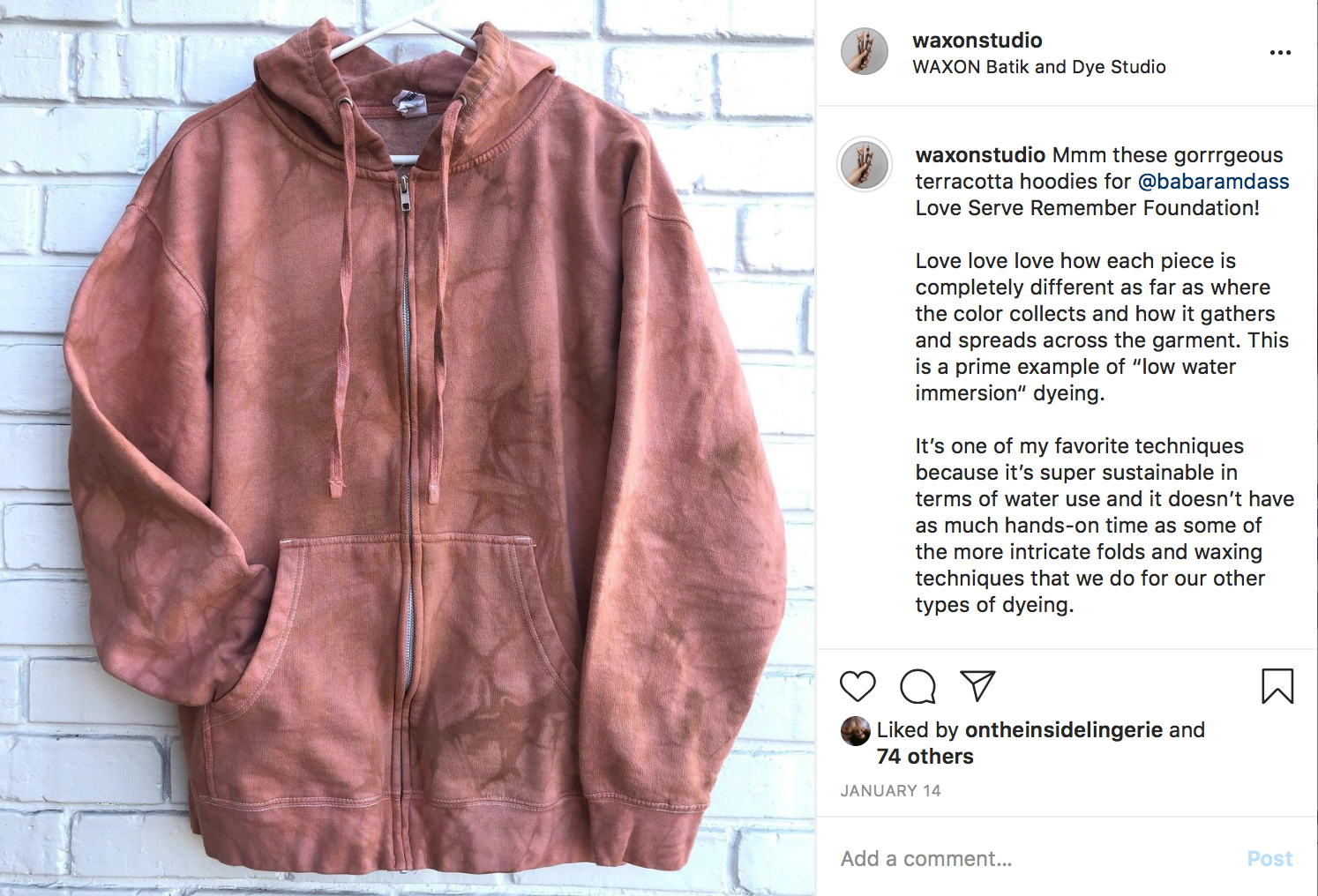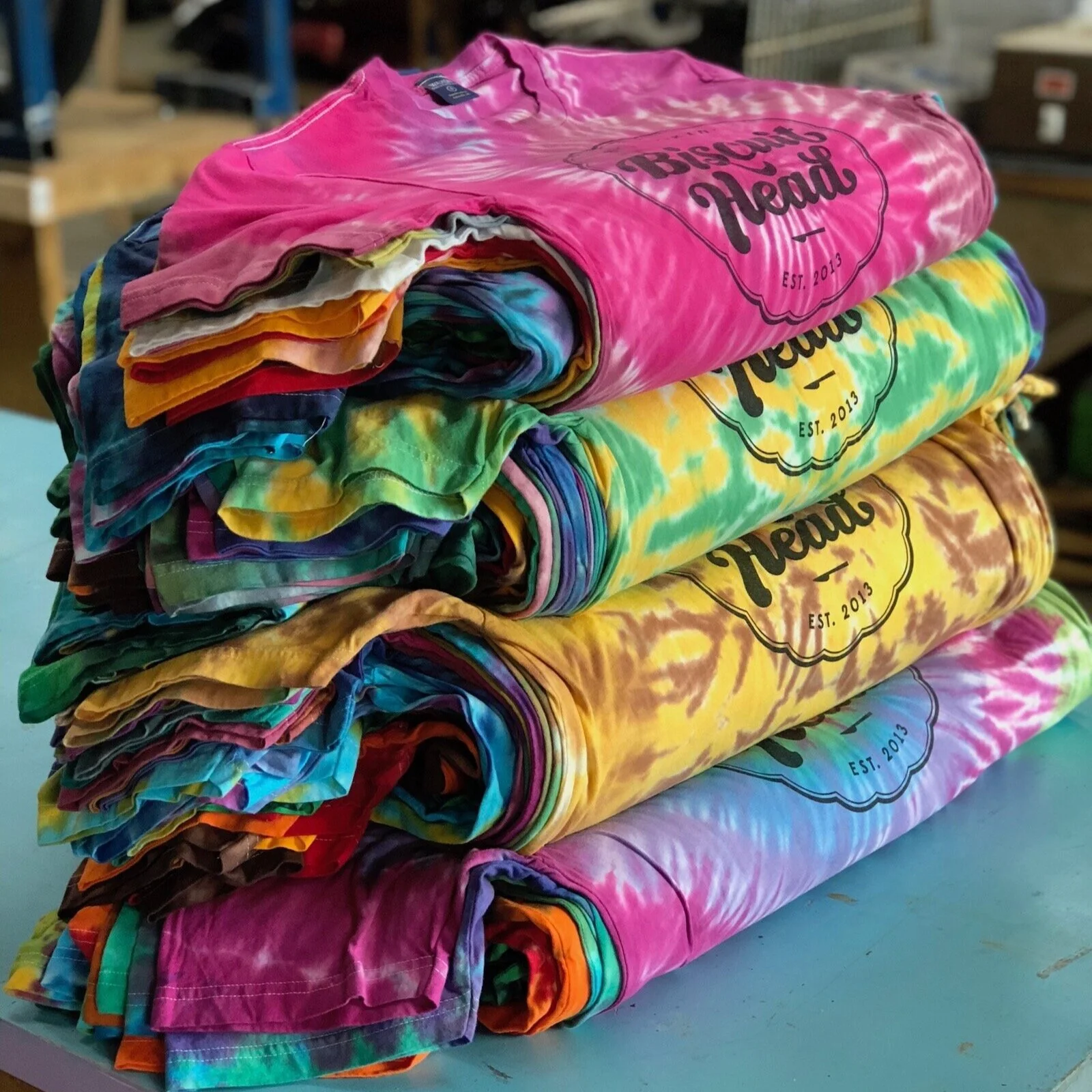How to Hire Someone to Dye Your Garments
So you have a brand, let’s say a clothing brand, and you really want that tie-dye look, but you’re not a dyer yourself. How do you do it? Do you take the time to teach yourself how to become a tie-dyer on YouTube? Who has the time for that? What about all the time you’ll spend messing up, learning what not to do, getting the wrong results, and making a big mess?
Okay, so maybe you should hire someone who’s already in that field, who knows more about what they’re doing. Where do you even start looking for a dye professional, how do you know that they even do the type of dyeing you’re interested in? What does the process look like?
I can answer those questions— because my little biz, WAXON Studio, is one of those places that designers and organizations come to in order to get their products dyed.
One of the biggest things to ask yourself is:
Do I want my stuff hand dyed? Or commercially dyed?
The difference is found in the desired finished look, the actual dyes used, and the processes the dye house uses to get there. At WAXON, we only use low-impact fiber reactive dyes, which only work on natural fibers, so right off the bat we’ve eliminated any brand that wants to use synthetic fabrics. No polyester, no nylon, no spandex, no plastics at all. And we don’t do solids. A brand might want to find a larger scale, commercial dye factory if those parameters don’t work for them.
This is a nice example of a dyer signaling that yes, they do bulk & custom orders, what they like to do for clients, and what type of dyeing it is! (If I don’t say so myself…lol)
How to find tie-dye and hand dyeing artists who might work with you
First of all, not every dyer likes doing custom work. There are a lot of fellow dyers that I follow on instagram who even write in their profile “no tutorials, no customs.” They like doing their own work and then trying to sell that work that’s already made. And that is totally legitimate! Other dyers prefer not to work on drops and shop stocking; they don’t want to make the work until they know you’re going to order it. Custom orders are some dyers’ bread and butter. Also totally legitimate! So it isn’t a great strategy to just cold-contact dyers— try to find ones who are already friendly to custom orders and see if they do bulk or batch orders.
So, knowing that, start looking for dyed products on Etsy, Instagram, Pinterest, or just a google search. Look for tie dye, ice dye, “hand dyed fabric” or “hand dyed clothing.” This will bring up lots and lots and LOTS of artists and brands. Prepare a statement that you can copy/paste to each person via email or private message. Something like “Hi, do you do bulk dyeing? I’m a {brand owner/clothing designer} and I love your work. Do you dye other people’s items for resale?” Or, if you don’t plan on reselling, you’re just looking for someone to do a bulk order for your team, group, family reunion, etc., ask, “Hi, do you do bulk orders? I’d be looking for {10+} shirts.” Or hoodies or whatever it is. Then look below for more questions you should ask.
What kind of dyeing do they do?
Tie dye? Ice dye? Overdyeing solids? Bleaching your logo into jean jackets? There’s a lot of options out there. This one is important because not all hand dyeing is created equal. If you want a subtle, low-water immersion style look, don’t turn to a tie-dye artist who specializes in “neon rainbow spirals.” And vice versa, if you like really saturated colors and bold patterns, make sure you are seeing that look in their social media posts or on their website or online store. Find the type of dyeing you love and see if that person takes custom or bulk orders! There’s low water immersion or “crystal wash” dyeing, traditional bottle tie-dyeing, ice dyeing, shibori, batik, reverse dyeing, and new methods are being invented every day.
Remember: dyeing is like painting. Just because someone uses paints to make their art, doesn’t mean they use the kind of paints that will get you the results that please your eye.
For example: at my shop, we absolutely do not offer solid garment dyeing. You’re not going to get a “commercially dyed” (aka totally solid) look from us, and we’re proud of that. It’s not our thing, we don’t do it well, and we don’t want to even try. Our best clients are the ones who wouldn’t dream of wanting a stone cold solid dye job— they love our hand dyed, mottled, gorgeous variances, and so do we.
It’s kind of like dating— find someone who has what you’re looking for, and don’t try to fit a square peg in a round hole.
Send them inspiration pics!
Just like you would if you were going in to see a new hairstylist. It’s so much easier to bring in pics to illustrate exactly what you’re looking for. And please, oh my god, don’t ask a dye artist to copy another dye artist’s work. That is SO tacky and uncomfortable! Why not just go to the original artist? Of course, if it’s a vintage piece or you have no idea where the photo came from, it’s okay to at least show it. But I like it best when clients show pics of my work to help me understand what they want, because then we both know it’s something I can do well. The dyer can always say “yes I can try that” or “no, I don’t think I can or would want to do that.” The dyer knows what is going to take a long and laborious time or not.
Questions that you (the client) should ask:
Have you ever done this type of look before? Do you have photos you can send me?
Do you provide the blanks (or fabric) or do I?
What kind of washout services do you include? (Will you need to do any post-dye processing or will your products arrive ready to wear?)
What colors/ designs are your favorite and least favorite to do? (A happy dyer does good work— if you’re asking them to do something they really don’t love, maybe find someone else who does like that type of dyeing!)
What’s your turnaround time? Do you have other orders ahead of me?
Can you make a sample before I order a bigger number? What do you do if I don’t like the sample or need changes?
Who will actually be doing the dyeing? The business owner? Their assistants or interns? Both? Neither? It matters, and it’s okay to ask.
And the obvious one: what are your price points? Your minimums? Price breaks for higher numbers? Most people across the creative fields already know what their wholesale prices are, but that’s usually for already made items, not customs. Expect higher prices for custom orders, even when ordering in bulk. It doesn’t work to just look at their Etsy shop’s retail pricing and expect to pay 50% of that! You’ll probably see a reduction in price if you’re ordering more. For example, I charge a lot more per piece to do 10 custom sweatshirts than I would if the same person wanted 100 sweatshirts. With larger orders I can plan ahead, clear out the calendar, and focus only on that one project for as long as it takes. Little “piddly” orders still get my time and devotion, but with less of a payday for me. It takes a lot of time to set up, plan, and execute a custom order, so doing it in smaller batches of smaller numbers is just plain more work than doing one large order.
See if they have a spec sheet or a pricing sheet that they can send you. I put ours right on our “Services” page, mostly to eliminate folks who don’t like our style or our price points. Also like dating— if you put it out there what you’re available for, it reduces your chances of getting your time wasted by someone who’s not on the same page. And you won’t waste their time, either!
Ideal Client Case Study: Biscuithead in Asheville
Here’s why we at WAXON, as professional dye artists, love doing custom work for Biscuithead:
They trust us to choose the colors. That freedom and trust feels so good! We get to use what we have on hand and let our imaginations soar. We know their brand and their look and what their customers and employees like. I know that wide open “you choose” freedom does not work for every business, but still, it’s so dreamy for us.
They always order at least 100 items, whether it’s shirts or tote bags. That means we can manage our studio time to really devote to a big order, mix all their dyes at once, and keep it all together from start to finish. And also:
They pay on time! There’s nothing like having to chase down clients to get them to pay up for the work you’ve already done that is sure to make a small business nervous! If you’re nervous about not having the cash up front to pay for a big dye order, talk with your dyer about deposits. Many of us will do the work for a 50% deposit because it shows that you’re serious. Just ask.



